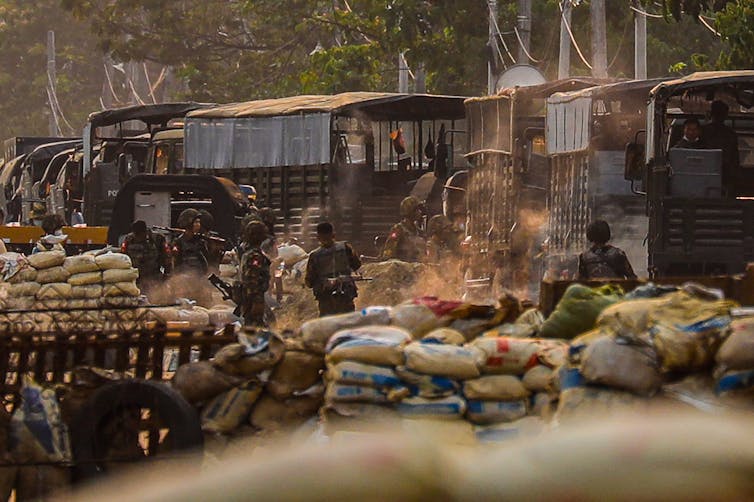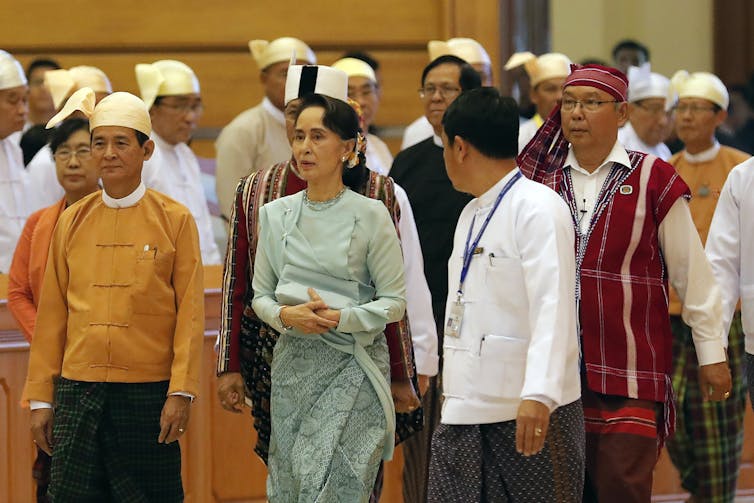Myanmar's anti-coup protesters defy rigid gender roles – and subvert stereotypes about women to their advantage
- Written by Ei Hlaing, Assistant Professor of Psychological Science, University of Lynchburg
One of the first signs of the military coup that overthrew Myanmar’s democratically elected civilian government was a Facebook Live video[1] of regional lawmaker Pa Pa Han[2] being arrested, which was posted by her husband.
Soldiers stormed Pa Pa Han’s home around 3 a.m. on Feb. 1, 2021. While her young daughter wailed and her husband pleaded to see an arrest warrant, Pa Pa Han stalwartly grabbed her handbag and a coat and left with the soldiers.
Other parliamentarians were simultaneously being roused from bed and arrested across Myanmar by soldiers who claimed election fraud had occurred in the November elections. By daybreak, Myanmar was under military rule.
Ever since, thousands of people in Myanmar – most of them young, many of them women – have been protesting the coup daily and demanding the restoration of democracy. More than 770 civilians[3] had been killed and over 3,738 detained as of May 6, according to the nonprofit Assistance Association for Political Prisoners[4].
Myanmar, formerly called Burma, is a conservative country with rigid gender roles. A 2015 survey[5] rated it Southeast Asia’s most traditional society when it comes to family structure, deference to elders, respect for authority figures and conflict avoidance.
Yet Myanmar’s Generation Z activists, born between 1997 to 2012, are defying many of these social norms with their protests – and busting gender stereotypes while they’re at it.
 Soldiers are seen near makeshift barricades set up by those protesting the military coup in Yangon, Myanmar, on March 14, 2021.
STR/AFP via Getty Images[6]
Soldiers are seen near makeshift barricades set up by those protesting the military coup in Yangon, Myanmar, on March 14, 2021.
STR/AFP via Getty Images[6]
A very traditional society
One act of creative resistance on March 8 involved hanging women’s sarongs on clotheslines above streets across Yangon. The young protesters suspected that many soldiers would avoid going underneath the clotheslines for fear that doing so would diminish their “hpon[7]” – a kind of mojo that belongs to only men.
They guessed right: Soldiers sent to arrest the protesters[8] climbed atop their army trucks to clear the clotheslines before passing underneath, giving protesters extra time to avoid arrest.
Such beliefs around “hpon” reflect a pervasive concept in Myanmar that men are superior to women and born with special spiritual protection. In a 2015 Asia Barometer survey, 60% of Myanmar respondents[9] agreed that if they could have only one child, a boy would be “preferable,” compared with 46% in the Philippines and 30% in Cambodia.
Having grown up in Myanmar, I was raised to believe in these same gender roles and sexist superstitions. After being exposed to a U.S. liberal arts education, I came to question the gender inequality buried in traditions and Burmese culture. Now, as a psychologist[10] who teaches about sex and gender, among other topics, I am tracking how Myanmar’s young protesters are rejecting sexism and subverting gender norms to their advantage.
After the sarong tactic, some of those activists questioned whether using sarongs to deter the soldiers might itself have been sexist because it played into old misogynistic superstitions. Shortly after the March 8 protest, activist Thinzar Shunlei Yi wrote on Twitter that women’s clothing should be flown proudly as “our flag, our victory[11]” – not used as a weapon.
Gender violence in Myanmar
Spousal rape and domestic violence is still legal and pervasive in Myanmar[12], and when it occurs people often blame the victims rather than the perpetrators.
On April 20, a 17-year-old coup protester named Shwe Yamin Htet, who had just been released from jail after six days, reported on social media[13] that a 19-year-old female protester detained with her had been “beaten with a metal pipe” and “kicked in her groin” and that her “vagina was bleeding due to the kicking.”
Rather than express outrage at the assault, some on social media worried that publicizing the young women’s sexual abuse would bring shame to her and asked Shwe to remove the post. She did not oblige.
A few women have defied the odds to obtain power in Myanmar – including the country’s deposed leader, Aung San Suu Kyi, who came to power in 2012. Rather than seeing her as an inspirational symbol of women’s leadership, however, researchers Mala Htun and Francesca Jensenius reported in their 2020 study[14] that most people in Myanmar view Aung San Suu Kyi simply as an exception.
Before the coup, women held 15% of political posts in Myanmar’s civilian government[15]. Now, just one woman sits on the coup regime’s 17-member state administration council.
 Aung San Suu Kyi with other top-ranking civilian leaders of Myanmar after her party won elections in March 2018.
Myat Thu Kyaw/NurPhoto via Getty Images[16]
Aung San Suu Kyi with other top-ranking civilian leaders of Myanmar after her party won elections in March 2018.
Myat Thu Kyaw/NurPhoto via Getty Images[16]
The military’s history of oppression
The military has run Myanmar as a dictatorship on and off since 1962[17]. In addition to airstrikes and attacks with heavy artillery, it is known to use sexual violence[18] as a weapon in its long-standing effort to crush separatist movements in the border regions of Myanmar.
Self-identifying ethnic Burmese make up 32% of the population. For nearly six decades, several ethnic minority groups – the Kachin, Karen and Karenni – have been fighting for autonomy and self-determination. For just as long, the Myanmar army has violently suppressed[19] them.
Human rights groups report[20] widespread and systematic rape in Karen state, in southwest Myanmar, over many decades. When women are captured by the military, soldiers use them as porters to carry shells during the day. At night, they may be gang-raped.
In Kayah state[21], another conflict zone north of Karen, women generally do not go out alone even for basics like groceries, because the military is known to target women.
The military oppression[22] and gender violence so familiar to rural Burmese in conflict zones is now affecting the urban middle and working classes[23] – groups that were long sheltered from the country’s borderland conflicts. On April 24, soldiers were reported to have physically abused a transgender woman who spoke out against the coup online[24], forcing her to change into “male” clothing before arresting her.
Women’s political future in Myanmar
Despite the risks, women continue to participate in the front lines[25] of Myanmar’s fight for democracy[26].
Some have been arrested, including Thin Thin Aung[27], co-founder of a leading independent news site called Mizzima, and union leader Myo Myo Aye[28]. Others were shot dead, like Khukhu Cilena[29], of the women’s rights group Women for Justice.
[Over 100,000 readers rely on The Conversation’s newsletter to understand the world. Sign up today[30].]
After the coup, a group of pro-democracy advocates formed a parallel government[31] called the National Unity Government[32] led by the elected lawmakers, which is financially supporting the civil disobedience movement[33]. Myanmar’s opposition lawmakers are also busting glass ceilings: Ethnic minority party affiliates make up 25% of its 32 members[34], women make up 28%, and one member identifies as LGBT – a first in Myanmar.
The National Unity Government and Generation Z offer Burmese society a vision of a more equitable, inclusive future – should democracy prevail.
References
- ^ video (www.youtube.com)
- ^ Pa Pa Han (www.reuters.com)
- ^ More than 770 civilians (www.aa.com.tr)
- ^ Assistance Association for Political Prisoners (aappb.org)
- ^ 2015 survey (www.asianbarometer.org)
- ^ STR/AFP via Getty Images (www.gettyimages.com)
- ^ hpon (www.japantimes.co.jp)
- ^ Soldiers sent to arrest the protesters (twitter.com)
- ^ 60% of Myanmar respondents (doi.org)
- ^ psychologist (scholar.google.com)
- ^ our flag, our victory (twitter.com)
- ^ still legal and pervasive in Myanmar (theconversation.com)
- ^ reported on social media (www.rfa.org)
- ^ Mala Htun and Francesca Jensenius reported in their 2020 study (doi.org)
- ^ 15% of political posts in Myanmar’s civilian government (theconversation.com)
- ^ Myat Thu Kyaw/NurPhoto via Getty Images (www.gettyimages.com)
- ^ has run Myanmar as a dictatorship on and off since 1962 (theconversation.com)
- ^ sexual violence (www.nytimes.com)
- ^ violently suppressed (www.reuters.com)
- ^ Human rights groups report (www.peacewomen.org)
- ^ Kayah state (doi.org)
- ^ military oppression (www.bbc.com)
- ^ affecting the urban middle and working classes (www.irrawaddy.com)
- ^ transgender woman who spoke out against the coup online (twitter.com)
- ^ women continue to participate in the front lines (womeninjournalism.org)
- ^ fight for democracy (www.cnn.com)
- ^ Thin Thin Aung (www.thecitizen.in)
- ^ Myo Myo Aye (www.business-humanrights.org)
- ^ Khukhu Cilena (www.fidh.org)
- ^ Sign up today (theconversation.com)
- ^ parallel government (asia.nikkei.com)
- ^ National Unity Government (www.irrawaddy.com)
- ^ civil disobedience movement (www.voanews.com)
- ^ 32 members (www.nugmyanmar.org)
Authors: Ei Hlaing, Assistant Professor of Psychological Science, University of Lynchburg

